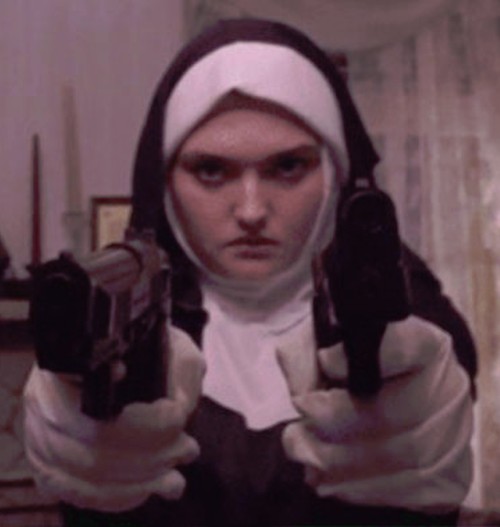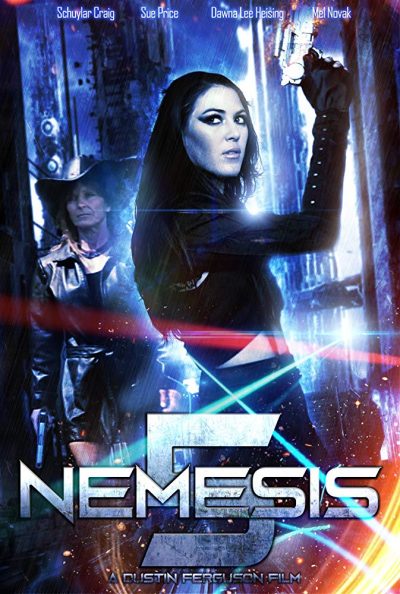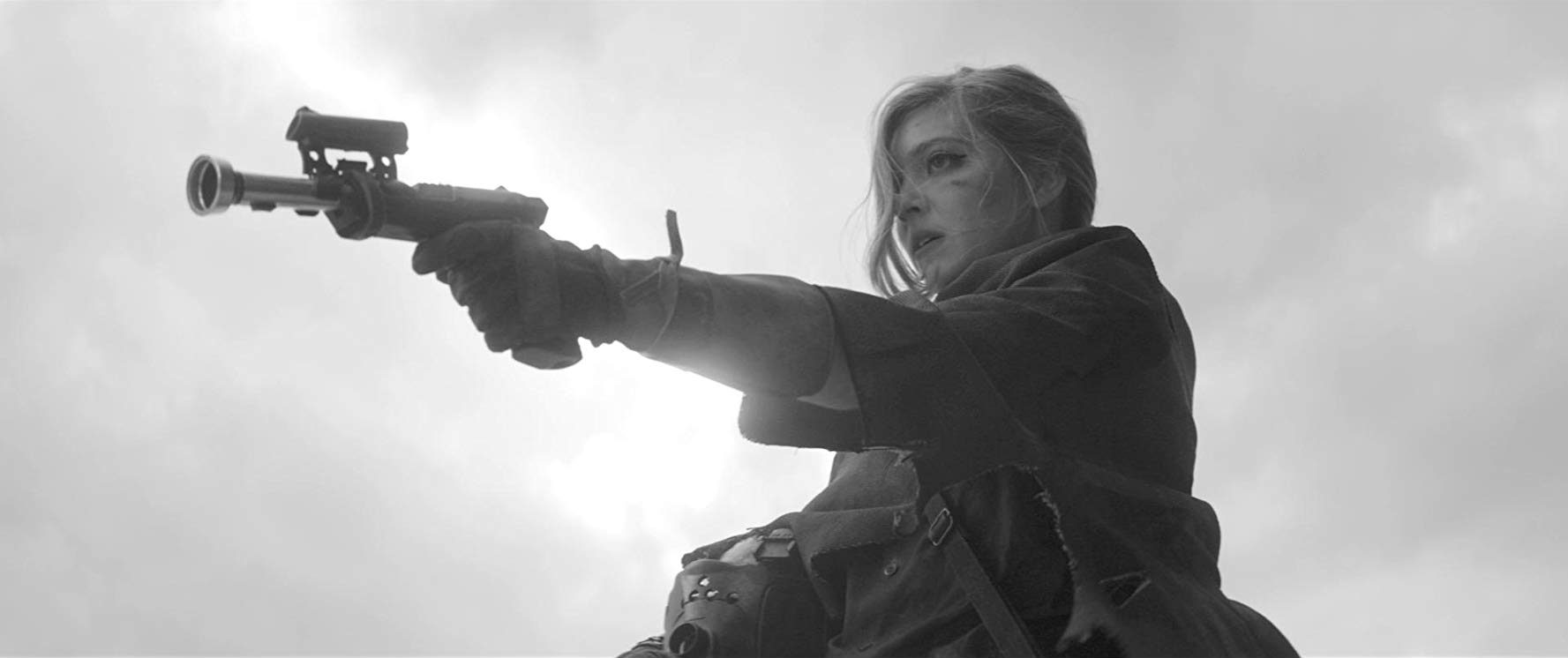★★★
“Jo…just Jo. Forget about the rest!”
 A couple of years ago when I wanted to rekindle my interest in anime, I stumbled over this series. Having been spoiled by the high quality of the GWG-anime Black Lagoon, I watched a couple of episodes of Burst Angel online, then left it and later couldn’t find it anymore. But also I didn’t bother, as the Youtube reviews I found painted a very dismal picture. According to one reviewer the series would later become stale, and always repeat the plot twist of the character of Meg being kidnapped and rescued by action girl Jo. Another – female – reviewer complained about the characters being sexually fetishized and getting bigger breasts in the inevitable “beach episode” (a standard in anime series which always gives a reason for some good-natured laughter).
A couple of years ago when I wanted to rekindle my interest in anime, I stumbled over this series. Having been spoiled by the high quality of the GWG-anime Black Lagoon, I watched a couple of episodes of Burst Angel online, then left it and later couldn’t find it anymore. But also I didn’t bother, as the Youtube reviews I found painted a very dismal picture. According to one reviewer the series would later become stale, and always repeat the plot twist of the character of Meg being kidnapped and rescued by action girl Jo. Another – female – reviewer complained about the characters being sexually fetishized and getting bigger breasts in the inevitable “beach episode” (a standard in anime series which always gives a reason for some good-natured laughter).
Flash forward to today when – after having consumed around 40-50 more anime shows – I rediscovered the show on the German amazon.prime. I have now seen the entire 24 episode run and can definitely revise my ill-informed opinion.
The story so far. Time: The future. Young student and upcoming cook Kyohei (Ueda) starts a new job, becoming cook to four girls of different ages. They all live in a very comfortable and large-sized mega-mobile home and also command a giant mecha. Financed by the mysterious organization “Bailan”, the four are always getting into action, after they get a (paid?) mission to fight monsters, giant robots or other strange creatures that suddenly appear.
Usually that means that tough grey-haired red-eyed Jo (Watanabe) gets into the mecha-armour and beats the opponent, until it stops moving. Who is behind these action usually stays unresolved. The other girls are Amy, a very young computer nerd; useless but obviously absolutely possessive Megan; and the older, leader of the team, Chinese girl Sei. Named after the characters in Little Woman (no, really!), they all assist and support Jo. And of course there’s Kyohei who is… just there. Which is strange, as it seemed in the beginning, he would be the main character – or that the story would at least be told from his perspective. But the series quickly all but forgets about him.
But to be honest, most of the characters don’t serve much purpose. The action usually centers almost all around Jo. Jo is a tough cooky from the street. As told in a short manga series, she and Megan originally formed a duo that would take on any job, before they formed a team with the other two girls. As a matter of fact, one episode even depicts how Jo meets Meg and her gang for the first time. Strangely, Meg appears in this episode much more grown-up and tougher than the rather infantile cry-baby she is depicted as, throughout most of the series.
The series is certainly not so uninspired or repetitive as one of the Youtube reviewers claimed it would be. It tells a range of stores stories, and also brings new elements into its narrative over its course. Every girl gets an episode where she can shine. So we see young Amy fight against robots in the Cyberworld, or Sei being confronted with a renegade faction within Bailan who wants to take over the organization by getting in possession of a powerful seal.
But the most interesting character is naturally the super-cool, calm Jo. Originally, my interest in the series grew because I thought she would be similar to Revy from “Black Lagoon”. Well, that might be a bit toi much of a compliment. While Revy is a three-dimensional character, Jo appears one-dimensional, almost a cliche, in comparison. The series gets its act together in the last few episodes when we discover Jo is one of two survivors from a biological weapon program run by an evil organization, who lost her memory. The show ends with her having to win her final fight, against the other, superior combatant spawned by the program.
This means lots of tears for Meg, as she clearly has to grow up now! ;-) In any way, while the series had a clear (and satisfying) ending, I amn’t so sure that things are quite as they seem, or that the dissolved team will never come together again. Though I hope the friendly Kyohei – whom I really wanted to see get a girl-friend – will find a better, or at least, more peaceful workplace in the future!
My personal judgement: Burst Angel is a good, solid and entertaining girls with guns show. There might be some improvements that could/should have been made but overall it’s good entertainment. Yes: stupid, sometimes downright silly Meg gets kidnapped more than once, though it didn’t bother me too much, and it’s not as apparent as you might think. I have much more an issue with the general uselessness of the character, though even she had an arc where she could do something, going undercover in a girl’s boarding school.
Concerning “sexually fetishization”… yeah, right. This is an anime show, what do you expect? But honestly, in comparison to other series – now I’ve got the experience to make a balanced judgement – the teasing is very limited. You want sexually fetishization? Watch “High School of the Dead” and then come back to the discussion. I’ve no problems with that, at least not in Burst Angel. You also don’t complain about Superman having a large chest or Batman wearing black latex and leather, do you?
Overall: A good show, though in the genre segment covering science fiction/fantasy action girls with guns, there are better shows with more developed characters. But as I said: I had a lot of mindless fun.
Dir: Koichi Ohata
Star: Akeno Watanabe, Megumi Toyoguchi, Rie Tanaka, Yūji Ueda






 Is it possible for a film to try and cram in too much? This might be guilty of that, being simply too full of ideas. It begins with a serial killer mother and son pair, who are also cannibals, to boot. They think they’ve found their next victims, when they pick up a pair of young hitchhikers, Ursula (Steadman) and Rose (Brown). However, the psychos are in for a shock, because their targets are actually a pair of vampires, centuries old. But, wait! There’s more! Weird meteorites have landed on Earth containing alien creatures, that devour human souls. Those they infect turn into aggressive, zombie-like creatures, that can only be terminated by destroying their pineal glands. And I haven’t even touched on Father Cooper (Travis), and his “nun with a gun” associate, Sister Gigi (Smith, right).
Is it possible for a film to try and cram in too much? This might be guilty of that, being simply too full of ideas. It begins with a serial killer mother and son pair, who are also cannibals, to boot. They think they’ve found their next victims, when they pick up a pair of young hitchhikers, Ursula (Steadman) and Rose (Brown). However, the psychos are in for a shock, because their targets are actually a pair of vampires, centuries old. But, wait! There’s more! Weird meteorites have landed on Earth containing alien creatures, that devour human souls. Those they infect turn into aggressive, zombie-like creatures, that can only be terminated by destroying their pineal glands. And I haven’t even touched on Father Cooper (Travis), and his “nun with a gun” associate, Sister Gigi (Smith, right). A promising idea has its concept snuffed out by shaky execution and even worse writing. Sam (Rogers) is a former solder and now single mother. When her child falls sick, Sam heads for the chemist’s for medicine. She never gets there, being abducted in a van and rendered unconscious. She wakes in a large warehouse-like facility in the middle of nowhere, which turns out to be a military production facility. She’s not the only woman there, and finds that an invisible adversary, using advanced tech to cloak his presence, is taking advantage of the weekend to turn the place into a stalker’s amusement park. However, Sam’s background perhaps gives her a very particular set of skills, unavailable to the other victims.
A promising idea has its concept snuffed out by shaky execution and even worse writing. Sam (Rogers) is a former solder and now single mother. When her child falls sick, Sam heads for the chemist’s for medicine. She never gets there, being abducted in a van and rendered unconscious. She wakes in a large warehouse-like facility in the middle of nowhere, which turns out to be a military production facility. She’s not the only woman there, and finds that an invisible adversary, using advanced tech to cloak his presence, is taking advantage of the weekend to turn the place into a stalker’s amusement park. However, Sam’s background perhaps gives her a very particular set of skills, unavailable to the other victims. This is the second book from Cooper here, after
This is the second book from Cooper here, after  It has been twenty years since
It has been twenty years since  Not sure I’ve ever read a book with three authors before, though Amazon omit Noe from the list given on Goodreads. This “novel by committee” might explain some of the problems with this, and its failure to mesh the two strands in any effective way. It’s a pity, as it starts off in entirely blistering fashion, with the arrival on Earth of the Syndicate, an extra-terrestrial invading army. We knew they were coming, so humanity’s forces take them on, in a massive and spectacular battle at their landing site in Mexico. It doesn’t go well for us, thanks to the attacker’s vastly superior technology. Survivors are few, but include Marines Quinn and Giovanni.
Not sure I’ve ever read a book with three authors before, though Amazon omit Noe from the list given on Goodreads. This “novel by committee” might explain some of the problems with this, and its failure to mesh the two strands in any effective way. It’s a pity, as it starts off in entirely blistering fashion, with the arrival on Earth of the Syndicate, an extra-terrestrial invading army. We knew they were coming, so humanity’s forces take them on, in a massive and spectacular battle at their landing site in Mexico. It doesn’t go well for us, thanks to the attacker’s vastly superior technology. Survivors are few, but include Marines Quinn and Giovanni. Or, perhaps: “What Blade Runner would have been like, if android Roy Batty was a good guy.” For this appears to be a mash-up of elements from that and Battle Angel Alita. While preceding the film version of the latter, it does seem to borrow elements of the manga, not least in its depiction of a future society where there is a strict, and basically vertical, division between the haves and the have-nots. After disease and pollution have pushed society to the brink, the rich and powerful live towards the top of a self-sufficient mega-city, under the control of ice queen Lady Jiru (Ishida) and her “Sodom” cyborg enforcers, leaving everyone else struggling for scraps down below. And leaving is a death sentence, due to the viruses infecting the outside world.
Or, perhaps: “What Blade Runner would have been like, if android Roy Batty was a good guy.” For this appears to be a mash-up of elements from that and Battle Angel Alita. While preceding the film version of the latter, it does seem to borrow elements of the manga, not least in its depiction of a future society where there is a strict, and basically vertical, division between the haves and the have-nots. After disease and pollution have pushed society to the brink, the rich and powerful live towards the top of a self-sufficient mega-city, under the control of ice queen Lady Jiru (Ishida) and her “Sodom” cyborg enforcers, leaving everyone else struggling for scraps down below. And leaving is a death sentence, due to the viruses infecting the outside world. In the late 22nd-century, Earth is pretty much screwed. The impact of a giant meteor killed a huge number of people, wiped out the everyday infrastructure, and sent the world into perpetual twilight. Thirty years ago, the wealthy upped and left, never to be seen again, abandoning the rest of the survivors to scramble in the ruins of civilization, simply trying to survive. Holly Danger is one of them, a salvager who lives by her wits in the labyrinth of a coastal city’s destruction. Which means dodging the seekers, addicts of the hyper-destructive drug, Plush, as well as the outskirts, those who come in to the city and raid it for supplies.
In the late 22nd-century, Earth is pretty much screwed. The impact of a giant meteor killed a huge number of people, wiped out the everyday infrastructure, and sent the world into perpetual twilight. Thirty years ago, the wealthy upped and left, never to be seen again, abandoning the rest of the survivors to scramble in the ruins of civilization, simply trying to survive. Holly Danger is one of them, a salvager who lives by her wits in the labyrinth of a coastal city’s destruction. Which means dodging the seekers, addicts of the hyper-destructive drug, Plush, as well as the outskirts, those who come in to the city and raid it for supplies. There are some very interesting ideas here. Unfortunately, probably too many of them. As a result, the end-product feels like a half-baked collection of semi-formed thoughts – none of which are explored to the extent they deserve. It begins with an apocalypse, apparently triggered in order to stave off an alien invasion. Fast-forward a few years, and we join Sarah (Hutchinson), one of four children who are shortly to be teleported to a space station orbiting around another planet, which is the target for future habitation, and where the President of Earth now resides. Except an alien sympathizer stages an assassination attempt, leaving the children dropped onto the planet’s surface, along with the Commanfer (Trigo), who had a role in the apocalypse seen earlier. But he ends up being taken over by a parasite which turns him psychotic and he begins hunting down the children. Who need to locate the President, who also crash-landed nearby, because…
There are some very interesting ideas here. Unfortunately, probably too many of them. As a result, the end-product feels like a half-baked collection of semi-formed thoughts – none of which are explored to the extent they deserve. It begins with an apocalypse, apparently triggered in order to stave off an alien invasion. Fast-forward a few years, and we join Sarah (Hutchinson), one of four children who are shortly to be teleported to a space station orbiting around another planet, which is the target for future habitation, and where the President of Earth now resides. Except an alien sympathizer stages an assassination attempt, leaving the children dropped onto the planet’s surface, along with the Commanfer (Trigo), who had a role in the apocalypse seen earlier. But he ends up being taken over by a parasite which turns him psychotic and he begins hunting down the children. Who need to locate the President, who also crash-landed nearby, because… This may be a first, in that the heroine here is non-human – contrary to what you (and, indeed, I!) might expect from the cover. I think I may have covered various crypto-humans before, such as vampires or elves. But this is likely the first entirely alien species. I began to suspect on page 1, when I read that Sah Lee “sank her pin-sharp teeth through the thick fur of the calf’s throat, and tasted the sweet metallic tang of its young blood.” This is clearly not your average twelve-year-old. And so it proves. The story really kicks under way two years later, when Sah Lee leaves her rural village on the planet of Aarn to attend school in the city of Aa Ellet.
This may be a first, in that the heroine here is non-human – contrary to what you (and, indeed, I!) might expect from the cover. I think I may have covered various crypto-humans before, such as vampires or elves. But this is likely the first entirely alien species. I began to suspect on page 1, when I read that Sah Lee “sank her pin-sharp teeth through the thick fur of the calf’s throat, and tasted the sweet metallic tang of its young blood.” This is clearly not your average twelve-year-old. And so it proves. The story really kicks under way two years later, when Sah Lee leaves her rural village on the planet of Aarn to attend school in the city of Aa Ellet.